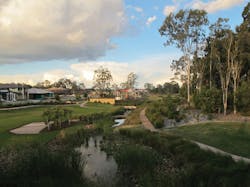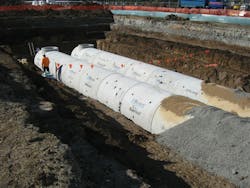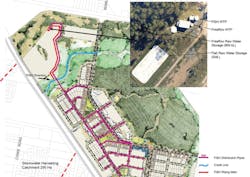Australia's new Fitzgibbon housing development is the country's first to supply treated stormwater for non-potable uses direct to homes. Add to that a roof water filtration system to augment drinking water and the decentralised system could be a win-win. A look at why the projects are receiving so much international attention.
by David Hamlyn-Harris
Located 12km north of the city of Brisbane, Queensland, Australia the 114 hectare Fitzgibbon Chase development is a new model of sustainable and affordable housing. It includes stormwater harvesting for non-potable reuse and roofwater harvesting for potable reuse. It demonstrates how a city can grow its water supply as it expands, while reducing the need for large capital investment and stormwater impacts on waterways.
Fitzgibbon Chase is predominantly residential, comprising a mixture of single detached to multi-unit dwellings including Terrace, Loft, Villa and Town Homes and traditional 'big block' family homes.
The Fitzgibbon Stormwater Harvesting (FiSH) scheme will supply treated stormwater to around 1,300 homes for non-potable uses via a dual reticulation (third pipe) system.
Furthermore, the Potable Roofwater (PotaRoo) harvesting scheme will harvest roofwater runoff from 500 homes in the development to augment the potable water supply. Together with the FiSH project, the PotaRoo will offset approximately 50% of the potable water supply needs for the development.
Treatment Process
These projects have been developed by Brisbane-based consulting engineers, Bligh Tanner. Participants included Economic Development Queensland (EDQ), the Queensland Government vehicle for delivery of sustainable affordable housing. Japanese engineering company, JFE Engineering, also assisted on the PotaRoo project.
The FiSH project was developed to demonstrate stormwater harvesting into residential areas for the supply of non-potable water for irrigation, toilet flushing, cold water laundry and outdoor uses. In doing so it meets the requirements for providing an alternative water source under the then Queensland Development Code, obviating the need for individual rainwater tanks on each house.
Stormwater is collected from a 290 hectare urban catchment and pumped via an oil and sediment trap into a 5,000 m3 covered and lined lagoon. The scheme harvests less than 10% of average annual runoff from the catchment and requires a pumped diversion rate of only 144 m3/hour, aimed to capture low rather than large storm flow events.
Water from the lagoon is treated through a 300 m3/day water treatment plant in accordance with Australian guidelines for non-potable residential use, including:
- Pre-filtration using an auto-strainer
- Sand filtration as the main filtration stage
- Activated carbon to remove organic chemicals
- UV disinfection as the primary disinfection process
- Residual chlorination (using sodium hypochlorite) before the treated water storage to provide a disinfectant residual.
It is estimated that the stormwater harvesting system will supply approximately 89,000 m3/year (63%) of water for non-potable uses including toilet flushing, cold water laundry, general external uses such as car washing, garden watering and public open space irrigation.
Construction of the FiSH diversion, storage and water treatment plant is complete and the purple pipe reticulation is already connected to around 350 homes. The water treatment plant commissioning has been completed, which subject to meeting various authority requirements, is expected to service the community by late 2013. Apart from water supply, the FiSH scheme provides a significant environmental benefit and cost savings for the development.
Water harvested from the drain has entrained pollutants in the water and by removing this water from the normal runoff, it also removes the pollutants.
Analysis shows that the amount of pollutants removed is of similar magnitude to the target urban stormwater pollutant reduction objectives that would normally require the construction of bio-retention filtration devices, wetlands or similar. This results in considerable money savings for the developer.
Roofwater to drinking water
The PotaRoo roofwater project was initiated by JFE Engineering to help prove technologies for producing potable water from roofwater runoff.
The objective is to collect roofwater from individual roofs to a series of communal collection tanks, transfer the collected water to a central raw water storage and treatment plant and then to inject the treated water directly into the town drinking water supply.
When complete, the Fitzgibbon potable water project will harvest roofwater from approximately 7.8 hectares of roof catchment (500 homes) in Fitzgibbon Chase. The down-pipes from each dwelling will be connected to the roofwater collection system, designed to accept up to 2.9 m3/hour per 100 m2 of roof catchment based on a rainfall intensity of 30 mm/hour. Water in excess of that amount surcharges the system into the stormwater drainage.
During small rainfall events, all roofwater will be collected; in larger events, excess runoff will overflow to the stormwater drainage system.
Each collection system drains to a local communal rainwater tank. Four local tanks for four separate sub-catchments have been provided with a total distributed storage volume of 915 m3. The tanks are constructed using a system based on buried reinforced concrete pipes located beneath parkland and road verges, providing flexible unobtrusive storage systems. From the local tanks, collected roofwater is pumped to the main 800 m3 raw water tank adjacent the water treatment plant.
The water will undergo a high level of treatment to achieve water of potable quality and be monitored to ensure that it meets the relevant water quality requirements. The 200 m3/day treatment system (developed by JFE Engineering Corporation) includes a multi-barrier approach incorporating:
- Pre-filtration using an auto-strainer
- Sodium hydroxide for pH adjustment
- Microfiltration as a direct physical barrier to contaminants and to provide consistent high quality treated water
- Activated carbon to remove organic chemicals, tastes and odours
- Ion exchange to remove zinc
- UV disinfection as an additional barrier to pathogens that does not require the use of chemicals
- Residual chlorination (using sodium hypochlorite) in the treated water storage and distribution system to reduce the chance of biofilms and aesthetic problems including off-tastes, odours and staining.
During the first phase of the project (short-term) the water will be injected into the non-potable harvested stormwater system. Following the validation of the treatment systems, it is intended that the water will be supplied into the main potable water supply.
The PotaRoo is estimated to yield approximately 44,000 m3/year or about 35% of the total potable water demand for the housing estate. Construction of the PotaRoo is largely complete except for the collection system, which is being progressively rolled out as the development proceeds. The water treatment plant has undergone initial commissioning testing and validation.
Plant operation and continued verification testing will commence in September 2014 once sufficient rooves will be connected to allow a reliable water supply into the system. Verification and assessment will continue for an extended period before the water will be deemed acceptable for direct potable use.
Challenges of decentralised systems
While decentralised water supplies could provide a substantial part of water needs over time, the challenge lies in the widely held belief in and commitment to large scale systems. Other challenges relate to the shortcomings of existing water policy that does not yet accommodate stormwater harvesting, issues of governance models and long-term stewardship of schemes and costs.
Cost issues relate to the need to optimise the unit cost of producing the water and also to the challenge of ensuring that the cost of new sources is compared against other new sources, rather than the traditional supplies that our regional systems rely on.
Achievements
The Fitzgibbon Chase project creates a new model for hybrid centralised/decentralised water supply systems.
When the PotaRoo scheme is connected to the South East Queensland Water Grid, it will ultimately supply potable water back into that grid, while having localised reuse of non-potable stormwater.
Using the approach being pioneered at Fitzgibbon Chase, cities can help meet the water demands of growing populations by augmenting water supplies as the city grows, thus deferring investment in major new sources of supply.
FiSH is an Australian first in the supply of treated stormwater for non-potable uses via dual reticulation (third pipe) systems into homes. It shows that water can be produced at comparable quality and cost to other options, at a local scale.
This broadens the suite of options available to water supply planners and land developers, especially in 'grid-interactive' local water supplies. It shows that the governance arrangements of decentralised systems - often regarded as an insurmountable barrier - are able to be resolved through genuine collaboration with the relevant water utility and regulators.
The projects to date are receiving widespread international attention, attracting delegations from Japan, China, Korea, Malaysia and Israel, recognised internationally as setting a new benchmark for creating water sensitive cities.
David Hamlyn-Harris is director of engineering consultancy, Bligh Tanner.






